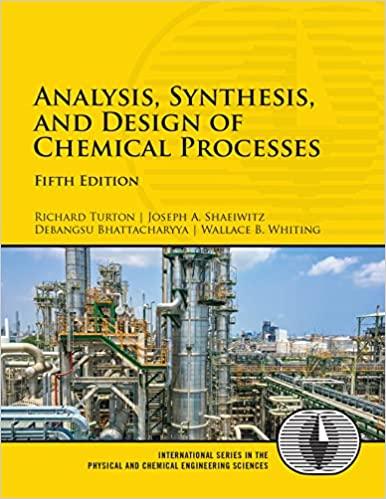How is Scotch whisky made? The following descriptions of malt and grain whisky manufacturing are given here
Question:
How is Scotch whisky made?
The following descriptions of malt and grain whisky manufacturing are given here courtesy of the University of Edinburgh at http://www.dcs.ed.ac.uk/home/jhb/whisky/swa/chap3.html.
For each of the two processes, sketch a process flo diagram.
There are two kinds of Scotch whisky: malt whisky, which is made by the pot still process, and grain whisky, which is made by the patent still (or Coffey still) process. Malt whisky is made from malted barley only, whereas grain whisky is made from malted barley together with unmalted barley and other cereals.
Malt Whisky
The pot still process by which malt whisky is made may be divided into four main stages: malting, mashing, fermentation, and distillation.
(1) Malting
The barley is first screened to remove any foreign matter and then soaked for two or three days in tanks of water known as steeps. After this it is spread out on a concrete floor known as the malting floor and allowed to germinate. Germination may take from 8 to 12 days depending on the season of the year, the quality of the barley used, and other factors. During germination the barley secretes the enzyme diastase, which makes the starch in the barley soluble, thus preparing it for conversion into sugar. Throughout this period the barley must be turned at regular intervals to control the temperature and rate of germination.
At the appropriate moment germination is stopped by drying the malted barley or green malt in the malt kiln. More usually nowadays malting is carried out in Saladin boxes or in drum maltings, in both of which the process is controlled mechanically. Instead of germinating on the distillery floor, the grain is contained in large rectangular boxes (Saladin) or in large cylindrical drums. Temperature is controlled by blowing air at selected temperatures upward through the germinating grain, which is turned mechanically. A recent development caused by the rapid expansion of the Scotch whisky industry is for distilleries to obtain their malt from centralized maltings that supply a number of distilleries, thereby enabling the malting process to be carried out more economically.
(2) Mashing
The dried malt is ground in a mill, and the grist, as it is now called, is mixed with hot water in a large circular vessel called a mash tun. The soluble starch is thus converted into a sugary liquid known as wort. This is drawn off from the mash tun, and the solids remaining are removed for use as cattle feed.
(3) Fermentation
After cooling, the wort is passed into large vessels holding anything from 9000 to 45,000 liters of liquid, where it is fermented by the addition of yeast. The living yeast attacks the sugar in the wort and converts it into crude alcohol. Fermentation takes about 48 hours and produces a liquid known as wash, containing alcohol of low strength, some unfermentable matter, and certai byproducts of fermentation.
(4) Distillation
Malt whisky is distilled twice in large copper pot stills. The liquid wash is heated to a point at which the alcohol becomes vapor. This rises up the still and is passed into the cooling plant, where it is condensed into liquid state. The cooling plant may take the form of a coiled copper tube or worm that is kept in continuously running cold water, or it may be another type of condenser.
The first distillation separates the alcohol from the fermented liquid and eliminates the residue of the yeast and unfermentable matter. This distillate, known as low wines, is then passed into another still, where it is distilled a second time. The first runnings from this second distillation are not considered potable, and it is only when the spirit reaches an acceptable standard that it is collected in the spirit receiver. Again, toward the end of the distillation, the spirit begins to fall off in strength and quality. It is then no longer collected as spirit but drawn off and kept, together with the first running, for redistillation with the next low wines.
Pot-still distillation is a batch process.
Grain Whisky
The patent still process by which grain whisky is made is continuous in operation and differs from the pot still process in four other ways.
1. The mash consists of a proportion of malted barley together with unmalted cereals.
2. Any unmalted cereals used are cooked under steam pressure in converters for about 3½ hours. During this time the mixture of grain and water is agitated by stirrers inside the cooker.
3. The starch cells in the grain burst, and when this liquid is transferred to the mash tun, with the malted barley, the diastase in the latter converts the starch into sugar.
4. The wort is collected at a specific gravity lower than in the case of the pot still process.
5. Distillation is carried out in a patent or Coffey still, and the spirit collected at a much higher strength.
Storage and aging of the whisky are also an important part of the overall process but need not be considered for this problem. Storage occurs in oak barrels that previously stored either sherry or bourbon (or both, in the case of double-aged whisky). The length of storage in the barrel determines the vintage of the whisky. Unlike wine, the time after bottling does not count, and so a 15-year-old scotch that was bought in 1960 is today still a 15-year-old scotch.
Step by Step Answer:

Analysis Synthesis And Design Of Chemical Processes
ISBN: 9780134177403
5th Edition
Authors: Richard Turton, Joseph Shaeiwitz, Debangsu Bhattacharyya, Wallace Whiting




